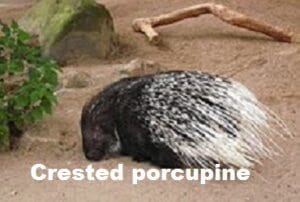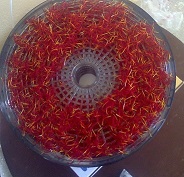Cultivation of Saffron (Crocus Sativa); A Compete Information Guide
Introduction;
Saffron (Crocus Sativa) is popularly known as ‘Kesar’ or ‘Kum – Kum‘ or ‘Lohit‘ It is one of the costliest spices in the world by weight The cost of 1 pound (0.453 kg) saffron is approximately $5000 If we compare it with 2nd costliest spice of the world that is vanilla at about $600 /pound
The deep red color stigma and style of saffron is known as thread and the dried threads of saffron are used for seasoning and coloring
Saffron belongs to the family Iridaceae it is a perennial plant of the regions that possess hot summers and cool winters. Saffron is a plant of low height 10-25 cm with a maturity period of 3 to 4 months Saffron is a native plant to Eastern Asia and Originated in Iran more precisely Alvand in the Zagrous mountain.
The Global Production of Saffron is approximately 300 tons/year. Iran is the pioneer country that occupies 88% of the area and the production of saffron. India ranks 2nd in saffron production and produces 7% of the total world production. Other major saffron-producing countries are Spain and Greece.
In India Saffron is mainly cultivated in the Pampore, Badgaon, Srinagar, and Kishtwar districts of the Jammu and Kashmir State it is cultivated in 3700 hectares area with an average production of 16 MT and Productivity of 4 kg/hectares
Why Saffron is Cultivated only in Limited regions of the World ?;
It is cultivated in limited geography due to the sterile nature of the saffron plant and sterile nature saffron can not be found as a wild plant hence it is cultivated only through bulbs only in a limited area where they are already in Cultivation.
Why Saffron is So Costliest Spice?
Two factors are mainly responsible for the high cost of saffron Viz;
1) Lower yields; The yields of a saffron crop are very low it is just 1.6 to 1.8 kg /per acre
2) Highly Labour Intensive Crop ;
a) Approximately 3,40000 flower picking is required to produce one kg of saffron and the entire process of flower picking is done manually to restrict losses in production because of floral damage.
b) The flower of saffron has three tiny thread-like stigmas at the center and these stigmas are separated from the flower by the laborer manually for the drying process.
c) To produce one kg of saffron approximately 360- 450 hours of men’s power are required.
Uses of Saffron ;
a) Medicinal uses;
1) Saffron helps in improving the symptoms of Alzheimer’s disease
3) Saffron Extract cures the symptoms of depression
5) Saffron is used in Ayurveda medicines to cure arthritis, infertility, fever, and Liver enlargements.
b) Other Uses;
1) It is used as a flavoring and clouring gents in sweets, Milk-based products
2) Saffron is used as a natural pigment in the cosmetic industry.
3) Saffron is used as a powerful seasoning agent in various cuisines of the world
Climatic Requirement of Saffron Cultivation;
1) Saffron is a warm-season subtropical crop It requires a temperature range of 35 – 40 degrees Celsius during the summers and 15 – 20 degrees Celsius in the winters
2) The saffron can be cultivated in dry, moderate, and continental climatic conditions only. Polar and tropical climatic conditions are not suitable for Saffron cultivations.
3) The saffron crop requires full bright sunny days for 12 hrs for its growth.
4) It can be grown well up to the elevation of 2000 feet with an average rainfall of 1000-1500 mm annually.
5) Low temperatures with high humidity during the flowering periods adversely affect the saffron crop
6) while the rains before the flowering boost the saffron crop yields
1) Sandy soils are the most suitable crops for saffron cultivation.
2) it can also grow comfortably on loamy sandy or Cacarious gravelly soils. The saffron crop requires.
3) Saffron crop is suitable to the optimum pH range of 6-8.
4) Heavy soils must be avoided for saffron Cultivation.
Land Preparation for Saffron Cultivation ;
Saffron Crop requires a clean, clod-free field with fine tilth for its successful establishment. The field should be ploughed and cross- harrowed 5 to 6 times followed by planking until a fine seedbed with good tilth is obtained.
Important Varieties of Saffron ;
|
Verities
|
Characteristics
|
|
Aquilla Saffron
|
1) This is the Iranian Saffron also known as Aquila
2) Plants are shorter and hence the thread length is also short.
3) The color is slightly less red than Kashmiri saffron.
4) It is the most abundantly available variety of saffron in the market 5) Since it is produced in bulk and is less costly than the Kashmiri variety.
|
|
Crème Saffron
|
1) This variety is used in the US and other countries and is of lower quality as compared to the Kashmiri or Iranian variety.
2) floral waste is higher in this variety and has a lot of yellow parts of the style.
3) It is the cheapest of all varieties of saffron available in the market. |
|
Lacha Saffron
or
Mongra
Saffron
|
1) Cultivated only in Kashmiri soil, this variety is the most popular of all.
2) It ranks number one in the world in terms of quality. The strands are dark crimson red.
3) They are exclusive to Kashmiri soil.
3)The flavor, aroma, and color that it imparts make it special worldwide.
4)This type of saffron is difficult to find outside India.
5) It is the most expensive type of saffron available in the market. |
Planting of Saffron;
a) Time of Planting;
The best time for saffron planting is between July to September it can be accomplished manually or by a machine.
b) Seed Rate;
50 Quintol of seeds material ( Corms) are required for a one-hectare area to maintain a planting density of 5 lakhs corms per hectare.
c) Planting of the Saffron Crop;
Vegetative Corms are used as a planting material to grow the saffron crop Always cultivate the saffron under a short life cycle of 4-5 years
1) Selection of Saffron Planting Material;
Select the corms of the size of 2.5 to 3.0 cm and weighing up to 8 gms. It should be free from injuries and disease lesions. Remove outer loosen scales before planting.
2) Corm Treatment ;
Treat the corms with 50 gms (0.1%) carbendazim 50 WP and with 150 gms of mancozeb 75 WP (.03%) in 50 liters of water. Dip the corms in the prepared solution at least 2-3 times for 5-10 mins each time. After treatment dry the corms in a shade for 15 – 20 mins.
3) Method of Planting;
Saffron corms can be planted directly into the field or they may be planted in prepared digs in a row with a spacing of 20X 10 cms @ 1 corm per hill or 20X15 cms @ 2 corms per hill at a depth of 15 cms.
Nutrient Management in Saffron Crop;
1) Apply well rotten FYM @10 tons per hectare and also apply vermicompost @5 tons per hectare.
2) Apply 90 kg of nitrogen, 60 kg of phosphorus, and 50 Kg of Potassium per hectare.
3) Apply a half dose of nitrogen and a full dose of phosphorous potassium, FYM, and Vermicompost at the time of the second hoeing of a present crop and the time of fresh planting. ( Aug – Sep)
4) Apply the rest of the nitrogen just after the flowering in the month of November.
Weed Management in Saffron Crop;
1) Weeds give significant losses to the saffron crop hence regular weeding is essential and should be done on a regular basis.
2) The first wedding should be done after 15 – 20 days of planting with the help of hoe thereafter 2nd weeding should be performed in the Ist fortnight of September.
3) weeding is very essential in the month of November and Feb for the proper development of the saffron crop.
4) Avoid any kind of chemical weedicide application to save the crop from the chemical residual effect on the saffron crop. You may go for the organic weedicide spray for controlling the weeds.
Irrigation in Saffron Crop ;
Most of the Saffron growers are dependent on the rains for irrigation or the majority of the saffron growing area is rainfed. Rains in the month of September are good for the vegetative and flowering stage of the crop But case if the rains are delayed or erratic adversely affects the crop growth and development.
For good vegetative growth, .pre and post-flowering stages developments, and good multiplication of corms, a sprinkler system of irrigation is highly recommended. the saffron crop should be irrigated by using the sprinkler System @ 7-meter cube/Ha(7lac liter/ha) and irrigation should be given in the ten splits at weekly intervals. The first irrigation should be started in the first fortnight of August depending upon the weather conditions. The first seven irrigation must be accomplished by the 15th of October using 70% of the required water and the rest 3 irrigation should be given in the month of November.
Rodent Management in Saffron;
Rodents provide considerable losses to the saffron crop per an estimated study that 3% damage to the saffron crop by rodents leads to Rs. 17 million losses annually.
Crested porcupine (Hystrix indica Kerr ) is the major rodent of the saffron crops at higher altitudes.
To control this pest fumigates the preidentified burrows with Allmunium Posphide pallets @ 2 pallets or 5- 10 gms pouch per burrow and covers it with wet mud.
Post Harvest Techniques for the Saffron Crop ;
To produce high-quality Saffron post-harvest stage is very critical for high recovery and quality.
a) Picking of the Saffron Flowers;
1) Age and collection of flowers directly influence the quality of the produce.
2) Picking must be properly scheduled it should be accomplished 2nd the day of flowering it will provide you with a good recovery and quality of the produce
3) Picking of the flowers must be done in the early morning.
4) Picked flowers must be accompanied by using the proper globes and they should be stored in the craft paper bags or plastic bags of good aeration
b) Separation of Stigma from the Saffron Flowers;
1) Stigma should be separated within 12 hrs of picking to achieve good pistil recovery and quality.
2) Any delay of 36 to 72 hours in the separation of the stigma from the flower causes huge losses in yield.
c) Drying of Saffron ;
Generally, farmers accomplish the drying process of saffron by spreading saffron in the shade for a long period of time 30 to 55 hrs, and such a long period of drying causes the degradation of the enzyme crocin and result in the deterioration of the product quality due to enzymatic activity Hence it is suggested to dry saffron in the hot air dryer at a temperature range of 40-50 degree celsius or in the solar dryer for 4-5 hours to exhibit pigmentation, texture, flavor, and bitterness close to the fresh flowers.
Perfect drying ensures clouring power (>300), Flavour (> 70), and bitterness (>120)
d)Packaging and Storage;
saffron can be stored in an air-tight container for 6 months with an initial moisture level of 8% at the temperature of 10 degrees Celsius. It can be stored in 10 gauge polybags or aluminum foils or in a metallic container for a period of one year at 15 to 35 degrees Celsius temperatures.
The yield of the Saffron ;
The yield of saffron depends on various factors like climate and the cultural practices adopted for cultivation. In India, on average it is approximately 2-7 kg per hectare. The average weight of a stigma is about 0.03 gm per flower and the dry weight is about 0.07 gm per flower. Approximately 150 flowers are required to collect 1 gm of stigma.









I like the way you break things down. Very helpful!